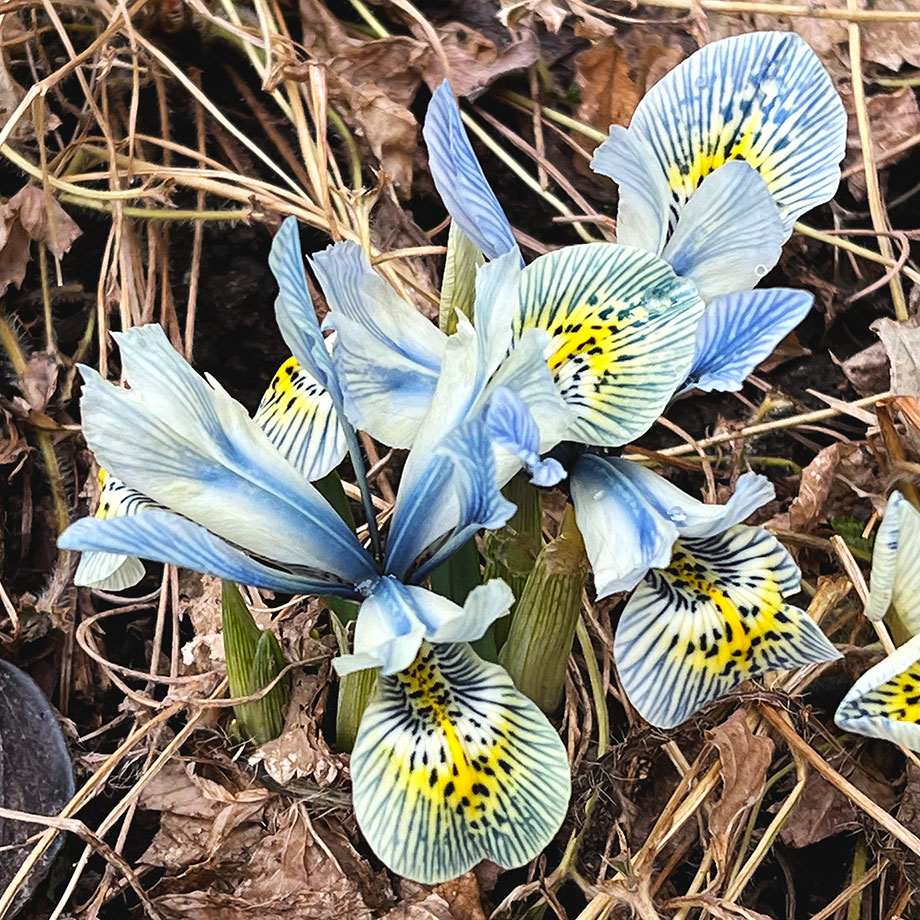June 5 Column: Spring-flowering bulbs

Today’s garden column is about spring-flowering bulbs. I know they’re nearly finished blooming and that it’s not time to plant more. But I’ve got some compelling reasons for talking about these lovely flowers! You can read my column in today’s edition of The Spokesman-Review: Plan ahead for next season’s spring bulbs at any time. Or you can read the text of my column underneath the video below. It also includes some important bulb-growing tips after they’ve finished blooming.
In the past few years, I’ve been adding some unusual spring-flowering bulbs to my garden. These include species tulips, Iris reticulata, Crocus tommasinianus, and some out of the ordinary grape hyacinths. Since you might not be familiar with some of them, I decided to create a slideshow of them for this week’s video.
The other thing I wanted to point out about my video is that I got my theme song back! If you’ve been following me for a while, you know I used to have a catchy theme song. Several months ago, Apple did an upgrade of iMovie, which is the editing software I use for my videos. I quickly discovered “my” song was gone from the options! I substituted another song and promptly received comments indicating that they preferred the old song! Well, it wasn’t anything I had control over, which was frustrating.
Apple just did another iMovie upgrade and guess what? Yup, my theme song was back! So life is good again. I hope you will enjoy my video:
Here’s my garden column:
by Susan Mulvihill
This might seem like a strange time of year to write about spring bulbs. After all, they’ve just about finished blooming, you can’t shop for them until late summer or early fall, and planting time won’t be until October or November, before the ground freezes.
But there’s a very good reason to talk about them now. This spring’s bulb show has been nothing short of spectacular. We can thank our cold, damp weather for that, even if it put the brakes on planting vegetable gardens.
Right now, while you can still see the remnants of your bulbs’ foliage, it’s time to take stock of which ones you grew, gaps in your landscape that would be ideally suited for growing bulbs and the types you’d like to add to your collection.
My many clumps of tulips were breathtaking this spring. I grow them in our backyard because it’s surrounded by a tall deer fence. Deer think tulips are delicious and I certainly don’t want to pamper them by planting tulips in the front flower beds.
In addition to growing a few varieties of Darwin tulips including Dordogne and Pink Impression, I’ve slowly been adding some species tulips to the mix. Even though they’re often more petite, they are stunning. Two years ago, I planted Dasystemon tulips which have bright yellow flowers with white tips. I’m happy to report they have started multiplying and really outdid themselves this year. Last fall, I planted Tubergen’s Gem (Tulipa clusiana var. chrysantha) which features yellow inner petals and red outer petals.
I’ve also ventured into green tulips. There are many different varieties that feature colorful petals with a stripe of green running through the middle. I selected Artist for its salmon-rose petals and green accents. When backlit by the sun, those blossoms are breathtaking.
Like most gardeners, I have a lot of clumps of grape hyacinths all over the place. I love their bright blue flower clusters but felt it was time to experiment with some of the more unusual types of Muscari. The flower spikes of Ocean Magic are deep purple at the bottom, baby blue in the middle and white at the top. I’ve also added some unusual grape hyacinths (Muscari macrocarpum) called Golden Fragrance, which have golden flower clusters topped with deep purple.
As you probably know, these are just the tip of the iceberg when it comes to what’s available. This is a great time to make plans for your fall planting, when garden centers and online bulb suppliers have received their new stock.
This is also the time of year to remember two important bulb-growing tips:
Once your bulbs have finished blooming, you will probably feel compelled to yank out the foliage. Avoid the temptation because as long as the leaves are green, they are conducting photosynthesis. This helps the bulb store energy for next year’s blooms. Once the leaves have died, you can remove them.
Remember to feed your bulbs after they’ve bloomed but while the leaves are still green. Use a fertilizer that is high in phosphorus (the middle number on the package). This will encourage next year’s flower production. Bonemeal is an organic soil amendment that will meet their needs. Commercial organic bulb fertilizers are also available at garden centers.
Look for a slide show of beautiful spring bulbs in this week’s video on my YouTube channel, youtube.com/susansinthegarden. They should inspire you to do a bit of shopping so you can enjoy more beauty in your garden next spring.
Susan Mulvihill is author of “The Vegetable Garden Pest Handbook.” She can be reached at Susan@SusansintheGarden.com.

